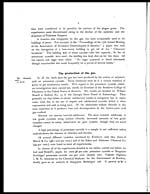Medicine - Institutions > Army health reports and medical documents > Scientific memoirs by officers of the Medical and Sanitary Departments of the Government of India > Number 38 - Preliminary report on the killing of rats and rat fleas by hydrocyanic acid gas > Preliminary report on the killing of rats and rat fleas by hydrocyanic acid gas
(9) [Page 1]
Download files
Individual page:
Thumbnail gallery: Grid view | List view
![(1) [Page 1] -](https://deriv.nls.uk/dcn17/7503/75033576.17.jpg)
PRELIMINARY REPORT ON THE KILLING OF RATS
AND RAT FLEAS BY HYDROCYANIC ACID GAS.
AT the suggestion of Captain W. Glen Liston, I.M.S., experiments with
hydrocyanic acid gas, as a measure to exterminate rats and fleas,
were commenced in May 1909. The first experiments were made under his
supervision.
We were later informed by Mr. Lefroy, the Imperial Entomologist, that
large use had been made of this gas by the Agricultural Departments in the
United States of America and in South Africa. He kindly sent us some of the
literature on the subject along with an account of his own experiments conducted
at Pusa, all of which have proved of great help to us.
It will be useful to consider briefly some of the previous work done on this
subject. Hydrocyanic acid gas was first used in 1886 by Coquillet in California
to destroy the " Cottony Cushion Scale" insect on plants; and later, fumigation
of nursery stock with this gas has become compulsory throughout certain of the
States. It is now used throughout Canada, the United States of America, South
Africa, and Australia, not only for the disinfection of nursery stock, but also as a
means of ridding orchard trees of their pests. More important for our purpose is
the use of the gas for the disinfection of houses, jails, and railway coaches. The
application has naturally been very limited on account of the deadly nature of the
gas. Most of the information on this point we have obtained from the Reports
of the Government Entomologist to the Cape of Good Hope for the years 1898
to 1901. In 1898 he considered the gas too dangerous for house disinfection;
but in 1900, at the request of the Colonial Office, he rid the Worcester jail of
the bed bug—"Acanthia lectularia"—by fumigation with hydrocyanic acid gas.
A year afterwards the buildings were still free from the pest. In 1901 he further
treated two more jails—Tokai and Kimberley—without any accident, although in
the latter jail so great a quantity of potassium cyanide was used as 271 lbs. At
the time the experiment was completely successful, although a year afterwards
the buildings were re-infested. He also notes in 1901 that the "use of the gas
for the destruction of vermin in sleeping carriages of the Cape Government
railways has now been practised for three years with perfectly satisfactory results
and without any accident."
There is also an interesting note to the effect that Professor W. J. Simpson
thought this gas might be utilised to cleanse premises in which cases of plague
had occurred, and experiments were actually undertaken to determine what mini-
mum strength of the gas might be necessary to destroy bed bugs, which at that
B
Set display mode to: Large image | Zoom image | Transcription
Images and transcriptions on this page, including medium image downloads, may be used under the Creative Commons Attribution 4.0 International Licence unless otherwise stated. ![]()
| Permanent URL | https://digital.nls.uk/75033574 |
|---|
| Shelfmark | IP/QB.10 |
|---|---|
| Additional NLS resources: | |




